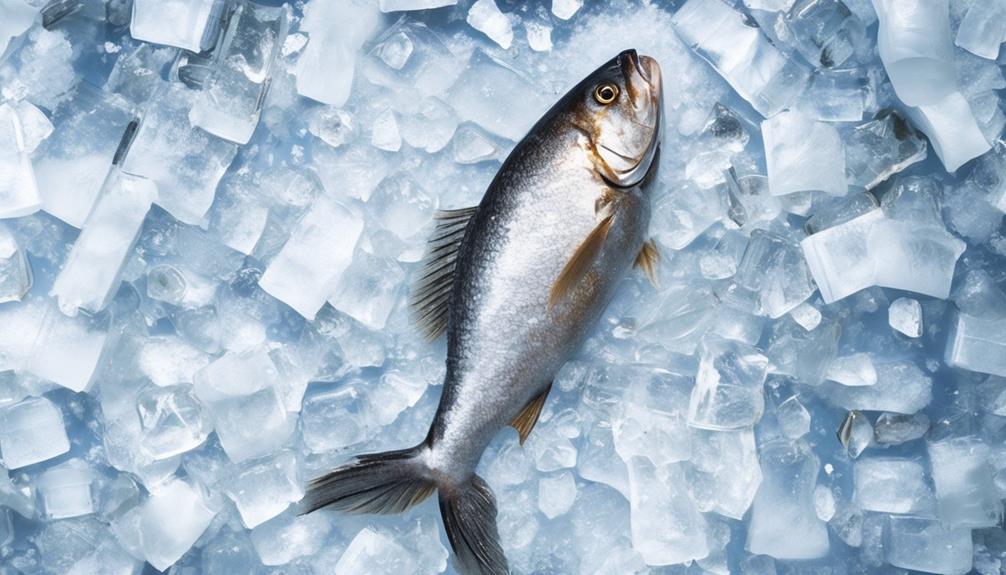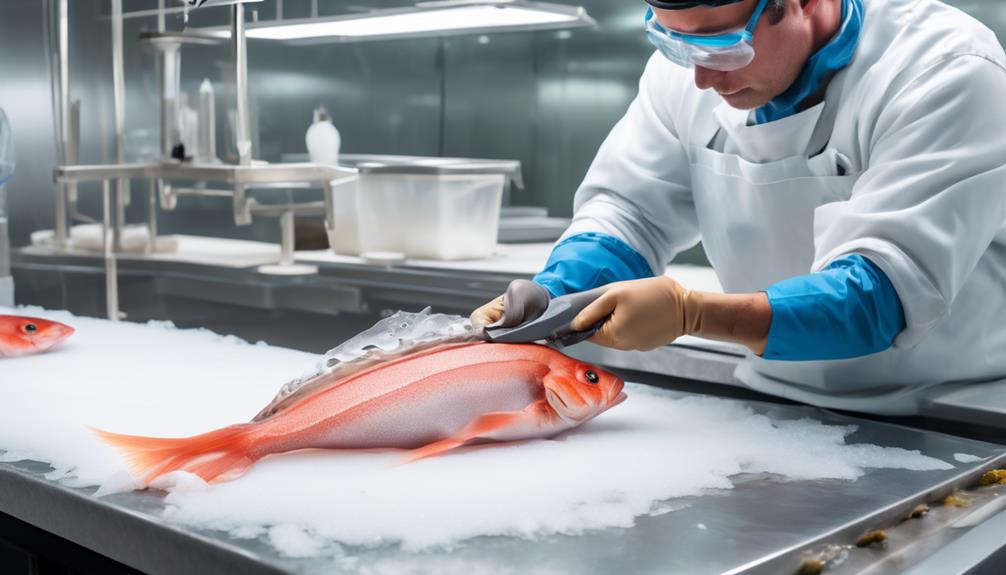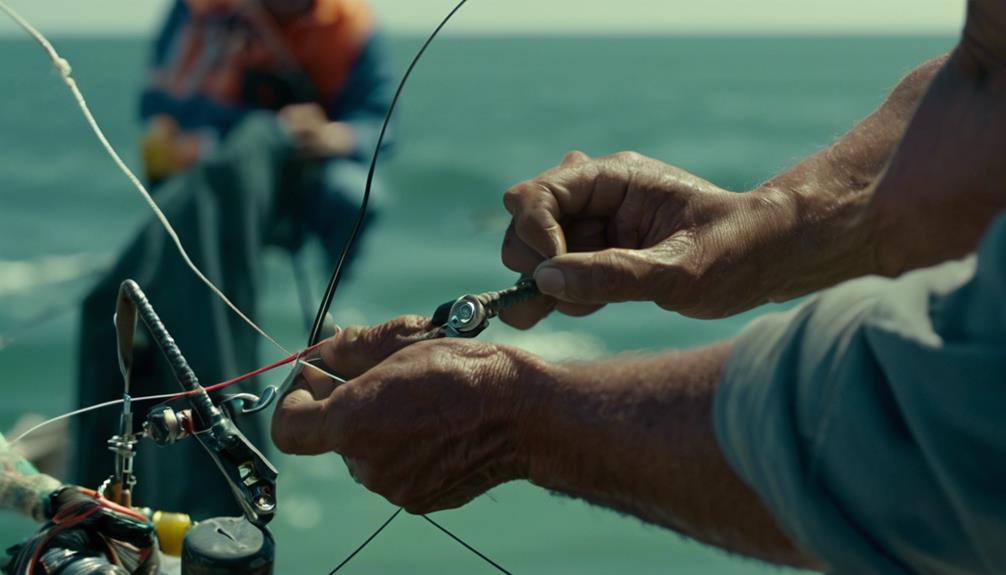Have you ever wondered if there are foolproof methods to effectively preserve saltwater fish? As a seafood enthusiast, you may have encountered various techniques, but it's crucial to discern which ones truly ensure the freshness and quality of the fish.
From proper handling and chilling methods to vacuum sealing and smoking procedures, the array of preservation techniques can be overwhelming. However, understanding the most effective methods is essential for maintaining the flavor and texture of saltwater fish.
Proper Handling Techniques
To ensure the best quality and freshness of saltwater fish, proper handling techniques are essential for preserving their flavor and texture. When it comes to storage solutions, it's crucial to keep the fish at the right temperature.
As soon as you catch or purchase the fish, make sure to store it on ice or in a refrigerator set to 32°F to 38°F (0°C to 3°C). This helps maintain the fish's freshness and prevents bacterial growth. Quality control is also paramount. Always inspect the fish for any signs of spoilage before storing or preparing it. Look for clear, bright eyes, vibrant skin color, and a fresh, ocean-like scent. If the fish has a strong, fishy odor or the eyes are cloudy, it's best to avoid using it.
When handling the fish, be gentle to avoid damaging the delicate flesh. Use a clean, sharp knife to fillet or portion the fish, and avoid tearing the meat. After handling, make sure to wash your hands and any utensils thoroughly to prevent cross-contamination.
Additionally, it's important to use suitable storage containers to prevent the fish from absorbing odors from other foods. Sealable plastic bags or airtight containers are excellent choices for storing fish in the refrigerator or freezer.
Chilling and Icing Methods
How can you ensure the freshness and quality of saltwater fish through proper chilling and icing methods?
When it comes to preserving saltwater fish, effective temperature control is crucial. Upon catching the fish, the first step is to immediately place them in a slush ice mixture. This method involves combining ice and water to create a slushy consistency, which helps maintain a consistent and near-freezing temperature around the fish. This ensures that the fish's natural juices remain intact and that the flesh stays firm and fresh.
Additionally, using storage solutions such as insulated fish bins or coolers with ice packs can help maintain the desired low temperature during transportation from the fishing vessel to the shore. The use of insulated containers prevents temperature fluctuations and helps to keep the fish at a safe and chilly temperature.
Once onshore, it's essential to transfer the fish to a cold storage facility or refrigerated room to maintain the freshness until further processing or distribution.
Gutting and Cleaning Process
After ensuring the fish is properly chilled and iced, the next step in preserving saltwater fish involves gutting and cleaning the fish to maintain its freshness and quality. Proper gutting and cleaning are crucial in preventing fish spoilage and ensuring optimal fish storage.
When you catch a saltwater fish, the first step is to ensure it's humanely killed. This can be achieved by quickly piercing its brain with a sharp object. Once the fish is dead, the gutting process should begin immediately.
Make a small incision near the fish's anal vent and carefully slice upwards towards the gills, taking care not to puncture the internal organs. Then, remove the entrails and rinse the body cavity thoroughly with clean, chilled seawater to remove any remaining blood or debris.
After gutting, carefully clean the exterior of the fish using seawater to remove any scales, slime, or residual blood. This ensures that the fish is clean and ready for storage.
Remember that a thorough gutting and cleaning process is essential for preventing fish spoilage and maintaining the quality of the fish during storage.
Vacuum Sealing
Consider using a vacuum sealer to remove air from the packaging and create an airtight seal around the fish, preserving its freshness for an extended period. Vacuum sealing is an effective method for long term storage of saltwater fish as it helps to prevent freezer burn and maintain the quality of the fish over time. By removing air from the packaging, the risk of oxidation is minimized, which in turn helps to retain the natural flavors of the fish, ensuring flavor retention even after extended periods of storage.
When it comes to long term storage, vacuum sealing provides an excellent solution for preserving saltwater fish. By creating an airtight seal, the fish is protected from freezer burn, which can compromise its texture and taste. This method not only extends the shelf life of the fish but also helps to maintain its quality, making it a favorable option for those looking to store fish for an extended duration.
Furthermore, vacuum sealing is beneficial for flavor retention. The absence of air in the packaging prevents the fish from being exposed to elements that can degrade its flavor. As a result, when you eventually decide to prepare the fish, it will still boast the fresh, delicious taste that you expect, even after being stored for a prolonged period.
Salting and Brining
To further preserve the freshness and flavor of your saltwater fish, another effective method to explore is salting and brining, which enhances the taste and extends the shelf life of the fish. Salting and brining are traditional techniques that have been used for centuries to preserve fish and other perishable foods.
Here are some methods that fall under salting and brining:
- Canning process: Canning involves sealing the fish in airtight containers and subjecting them to high heat, killing microorganisms and enzymes that cause spoilage. The result is a well-preserved fish product that can last for an extended period.
- Pickling methods: Pickling fish involves immersing them in a solution of vinegar, salt, and spices, which not only enhances the flavor but also acts as a preservative. The acidic nature of the pickling solution inhibits the growth of bacteria, keeping the fish fresh for a longer time.
- Fermentation techniques: Fermenting fish, such as in the case of salted fish or fish sauce, involves the action of beneficial bacteria that break down proteins and produce compounds that prevent spoilage. This method not only preserves the fish but also imparts unique flavors.
In addition to salting and brining, other preservation methods like the dehydration process can also be explored to extend the shelf life of saltwater fish. These methods offer a variety of options for preserving saltwater fish, allowing you to enjoy their freshness and flavor over an extended period.
Smoking and Drying Procedures
Curiously, have you ever wondered how smoking and drying procedures can enhance the flavor and shelf life of saltwater fish? Well, smoking and drying are traditional methods that not only add a rich, smoky flavor to the fish but also contribute to its preservation.
When it comes to flavor enhancement, smoking saltwater fish infuses it with a distinctive smoky taste that's highly sought after by seafood enthusiasts. The process involves exposing the fish to wood smoke, which imparts a unique flavor profile while also acting as a natural preservative.
Additionally, drying the fish removes moisture, intensifying its flavor and allowing for longer shelf life.
Furthermore, health considerations play a significant role in smoking and drying saltwater fish. The smoking process not only enhances the taste but also aids in preserving the fish by reducing water activity, which inhibits the growth of microorganisms that can cause spoilage.
Moreover, drying the fish eliminates moisture, preventing the growth of bacteria and other pathogens. However, it's important to note that proper smoking and drying procedures must be followed to ensure food safety. This includes controlling the temperature during smoking and ensuring thorough dehydration during the drying process.
Freezing Best Practices

After exploring the traditional methods of smoking and drying saltwater fish for flavor enhancement and preservation, it's important to now focus on the best practices for freezing to maintain the fish's quality and extend its shelf life.
When freezing saltwater fish, it's crucial to pay close attention to temperature control. The fish should be rapidly cooled to a temperature below -18°C (0°F) to ensure the formation of small ice crystals, which helps preserve the texture and flavor. Additionally, ensuring that the freezer maintains a consistent temperature is essential for preventing freezer burn and maintaining the fish's quality over time.
Proper storage solutions are also vital for effective saltwater fish preservation. Using airtight, moisture-proof packaging such as vacuum-sealed bags or freezer-safe containers can help prevent freezer burn and protect the fish from absorbing other odors in the freezer. Labeling the packages with the date of freezing can also help you keep track of the fish's freshness and ensure that older fish is used first.
Lastly, arranging the fish in a single layer in the freezer initially and then organizing them efficiently once they're frozen solid can help prevent the pieces from sticking together and allow for easier portioning when needed.
Following these freezing best practices can significantly contribute to maintaining the quality and flavor of saltwater fish while extending its shelf life.
Using Commercial Preservatives
You can enhance the preservation of saltwater fish by using commercially available preservatives. Commercial preservatives such as brine solutions, citric acid, and sulfites can effectively prolong the shelf life of saltwater fish. These preservatives work by inhibiting the growth of microorganisms and slowing down the process of spoilage. However, it's important to use these preservatives in the correct concentrations and follow the recommended guidelines to ensure both effectiveness and food safety.
When considering the use of commercial preservatives, it's also important to explore natural alternatives. Some natural compounds such as salt, vinegar, and certain herbs and spices possess antimicrobial properties that can aid in fish preservation. These natural alternatives can be just as effective as commercial preservatives but with fewer potential side effects.
It's also crucial to consider the environmental impact of using commercial preservatives. While they're effective in preserving fish, some preservatives may have adverse effects on the environment if not properly disposed of. For example, sulfites can be harmful to aquatic life if they leach into waterways. Therefore, it's important to use commercial preservatives responsibly and dispose of them in accordance with environmental regulations.
Frequently Asked Questions
Can Saltwater Fish Be Preserved Using Natural Methods Without the Use of Commercial Preservatives?
You can preserve saltwater fish using natural methods without commercial preservatives. Consider alternative techniques like curing, drying, and smoking. Cultural practices and traditional methods, such as brining and fermenting, also ensure effective fish preservation.
Are There Any Specific Types of Saltwater Fish That Are More Difficult to Preserve Than Others?
Preserving different saltwater species poses various challenges due to their unique characteristics. Using proper preservation techniques like freezing, brining, and smoking can help mitigate difficulties in preserving more delicate saltwater fish types.
What Are the Potential Risks and Concerns Associated With Improper Fish Preservation Techniques?
Improper fish preservation can lead to potential health risks and spoilage concerns. It's crucial to handle and store saltwater fish properly to avoid bacterial contamination and degradation. Pay attention to temperature control and sanitation practices.
How Do Environmental Factors, Such as Temperature and Humidity, Impact the Effectiveness of Saltwater Fish Preservation Methods?
Environmental factors like temperature and humidity play a crucial role in saltwater fish preservation. Salinity and oxygen levels impact preservation effectiveness, while bacteria contribute to spoilage. Understanding these factors is essential for successful preservation.
Are There Any Cultural or Traditional Methods of Saltwater Fish Preservation That Are Still Used Today?
To preserve saltwater fish, cultural methods and traditional techniques are still used today. These practices reflect the deep-rooted traditions of coastal communities and can be effective in ensuring the long-term preservation of fish resources.
Conclusion
So, now you know the various methods for effective saltwater fish preservation.
By following proper handling techniques, chilling and icing, gutting and cleaning, vacuum sealing, salting and brining, smoking and drying, freezing, and using commercial preservatives, you can ensure the freshness and quality of your saltwater fish for longer periods of time.
Happy fishing and preserving!



